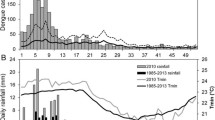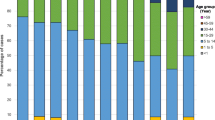Abstract
Identifying the impact of climatic factors on mosquito population dynamics is of great importance for dengue outbreak control. The purpose of this study is to develop an approach to predict spatial/temporal mosquito reproduction and disease outbreaks. The prediction of a dengue outbreak is only possible if the temporal relationship between mosquito replication and the weather is known. At present, this is unclear and needs to be examined. Moreover, because the development of mosquito density is a dynamic process in the course of time, it should be observed as closely as possible, in this study in a 1-day timeframe. This paper makes a thorough study of the situation in southern Taiwan and analyzes a large amount of data from 1999 to 2004 related to dengue cases and larval density. We first use the method, k-means, to conduct data clustering and derive representative larvae replication patterns. Then, we propose mathematical models to approximate the development of larval density, describe the expansion of mosquito activity areas, and construct a surveillance system to raise alerts based on real-time input of weather data and larval indices. Analysis of historic data reveals some new information on the spatial and temporal relationships between larval density and dengue outbreaks. In Taiwan, if the weather becomes or remains warm and humid for 6 days after a bout of rain, there can be a sharp increase in the larval mosquito population. About 7 days after the Breteau index begins to rise, larval density reaches its climax; and, about 12 days after the climax of larval density, cases of dengue may be reported. The system is tested using subsequent data from 2005 to 2009 and shows satisfactory accuracy. Numerous data support these findings, and this new knowledge is thus validated and can be used to assist public health professionals to take effective dengue control measures.






Similar content being viewed by others
References
Burattini MN, Chen M, Chow A, Coutinho FAB, Goh KT, Lopez LF, Ma S, Massad E (2008) Modelling the control strategies against dengue in Singapore. Epidemiol Infect 136(3):309–319
de Wet N, Slaney D, Ye W, Warrick R, Hales S (2005) Hotspots for biosecurity and vector-borne disease risk analysis. In: 1st National symposium on conservation medicine, 7–8 July, Auckland
Eamchan P, Nisalak A, Foy HM, Chareonsook OA (1989) Epidemiology and control of dengue virus infections in Thai village in 1987. Am Soc Trop Med Hygiene 41(1):95–101
Favier C, Degallier N, Dubois MA (2005) Dengue epidemic modeling: stakes and pitfalls. Asia Pacific Biotechnol News 9(22):1191–1194
Focks DA, Daniels E, Haile DG, Keesling JE (1995) A simulation model of the epidemiology of urban dengue fever: literature analysis, model development, preliminary validation, and samples of simulation results. Am Soc Trop Med Hygiene 53(5):489–506
Goh KT, Ng SK, Chan YC, Lim SJ, Chua EC (1987) Epidemiological aspects of an outbreak of dengue fever/dengue haemorrhagic fever in Singapore. Southeast Asian J Trop Med Public Health 18(3):295–302
Grigg M, Alfred B, Keller C, Steele JA (2006) Implementation of an Internet-based geographic information system: the Florida experience. J Public Health Manage Practice 2(2):139–145
Gubler DJ (2002) Epidemic dengue/dengue hemorrhagic fever as a public health, social and economic problem in the 21st century. Trends Microbiol 10(2):100–103
Gubler DJ, Clark GG (1995) Dengue/dengue hemorrhagic fever: the emergence of a global health problem. Emerg Infect Dis 1(2):55–57
Guzmán MG, Kouri G (2002) Dengue: an update. Lancet Infectious Dis 2(1):33–42
Hales S, Wet N, Maindonald J, Woodward A (2002) Potential effect of population and climate changes on global distribution of dengue fever: an empirical model. Lancet 360(9336):830–834
Halide H, Ridd P (2008) A predictive model for dengue hemorrhagic fever epidemics. Int J Environ Health Res 18(4):253–265
Halstead SB (2005) Dengue: an update. Asia Pacific Biotechnol News 9(22):1187–1190
Harris E, Roberts TG, Smith L, Selle J, Kramer LD, Valle S, Sandoval E, Balmaseda A (1998) Typing of dengue viruses in clinical specimens and mosquitoes by single-tube multiplex reverse transcriptase PCR. J Clin Microbiol 36(9):2634–2639
Hawley WA (1998) The biology of Aedes albopictus. J Am Mosquito Control Assoc Suppl 1:1–39
Hayles LB, McLintock J, Saunders JR (1972) Laboratory studies on the transmission of Western Equine Encephalitis virus by Saskatchewan mosquitoes 1 Culex tarsalis. Can J Comp Med 36:83–88
Heintze C, Garrido MV, Kroeger A (2007) What do community-based dengue control programmes achieve? A systematic review of published evaluations. Trans R Soc Trop Med Hyg 101:317–325
Hu W, Tong S, Mengersen K, Oldenburg B (2006) Rainfall, mosquito density and the transmission of Ross River virus: a time-series forecasting model. Ecol Model 196(3–4):505–514
Hurtado-Diaz M, Riojas-Rodriguez H, Rothenberg SJ, Gomez-Dantes H, Cifuentes E (2007) Short communication: impact of climate variability on the incidence of dengue in Mexico. Trop Med Int Health 12(11):1327–1337
Hwang JS (1993) Ecology and integrated control of Aedes mosquitoes in dengue epidemic areas in Taiwan (in Chinese). Ph.D. thesis, National Taiwan University, Taiwan, R.O.C
Juliano SA, Lounibo LP (2005) Ecology of invasive mosquitoes: effects on resident species and on human health. Ecol Lett 8:558–574
Kay BH, Nam VS, Tien TV, Yen NT, Phong TV, Diep VT, Ninh TU, Bektas A, Aaskov JG (2002) Control of Aedes vectors of dengue in three provinces of Vietnam by use of Mesocyclops (Copepoda) and community-based methods validated by entomologic, clinical, and serological surveillance. Am J Trop Med Hyg 66:40–48
Keating J (2001) An investigation into the cyclical incidence of dengue fever. Soc Sci Med 53(12):1587–1597
Kuhn K, Campbell-Lendrum D, Haines A, Cox J (2005) Using climate to predict infectious disease epidemics. World Health Organization, Geneva
Kuno G (1995) Review of the factors modulating dengue transmission. Epidemiol Rev 17(2):321–335
Larkin TS, Sweeney AW, Carruthers RI (1995) Simulation of the dynamics of a microsporidian pathogen of mosquitoes. Ecol Model 77:143–165
Li CF, Lim TW, Lee HL, Fang R (1985) Rainfall, abundance of Aedes aegypti and dengue infection in Selangor, Malaysia. Southeast Asian J Trop Med Public Health 16(4):560–568
Lien JC (1988) On the bionomics of Aedes (Stegomyia) mosquitoes in Taiwan (in Chinese). In: Proceedings of the first seminar on the control of vectors and pests. Environmental Protection Administration, Taiwan, ROC, pp 63–74
Lien JC (2004) Indices of Aedes in Taiwan (in Chinese) http://www.books.com.tw/exep/prod/booksfile.php?item=0010278495. Accessed on June 25, 2005
Mackenzie JS, Gubler DJ, Petersen LR (2004) Emerging flaviviruses: the spread and resurgence of Japanese encephalitis, West Nile and dengue viruses. Nat Med 10(12):98–109
McMeniman CJ, Lane RV, Cass BN, Fong AWC, Sidhu M, Wang YF, O’Neill SL (2009) Stable introduction of a life-shortening Wolbachia infection into the mosquito Aedes aegypti. Science 323:141–144
Medeiros LCdC, Castilho CAR, Braga C, de Souza WV, Regis L, et al (2011) Modeling the dynamic transmission of dengue fever: investigating disease persistence. PLoS Negl Trop Dis 5(1):e942. doi:10.1371/journal.pntd.0000942
Moore CG, Cline BL, Ruiz-Tiben E, Lee D, Romney-Joseph H, Rivera-Correa E (1978) Aedes aegypti in Puerto Rico: environmental determinants of larval abundance and relation to dengue virus transmission. Am J Trop Med Hyg 27:1225–1231
Mourya DT, Yadav P, Mishra AC (2004) Effect of temperature stress on immature stages and susceptibility of Aedes Aegypti mosquitoes to Chikungunya virus. Am Soc Trop Med Hygiene 70(4):346–350
Nagao Y, Thavara U, Chitnumsup P, Tawatsin A, Chansang C, Campbell-Lendrum D (2003) Climatic and social risk factors for Aedes infestation in rural Thailand. Trop Med Int Health 8(7):650–659
Ndiaye PI, Bicout DJ, Mondet B, Sabatier P (2006) Rainfall triggered dynamics of Aedes mosquito aggressiveness. J Theor Biol 243(2):222–229
Nelson MT (1986) Aedes aegypti: biology and ecology. PAHO/WHO Collaborating Centers, Washington, DC
Ordonez C (2006) Integrating K-means clustering with a relational DBMS using SQL. IEEE Trans Knowl Data Eng 18(2):188–201
Pontes RJ, Freeman J, Oliveira-Lima JW, Hodgson JC, Spielman A (2000) Vector densities that potentiate dengue outbreaks in a Brazilian city. Am J Trop Med Hyg 62:378–383
Porphyre T, Bicout DJ, Sabatier P (2005) Modelling the abundance of mosquito vectors versus flood dynamics. Ecol Model 183:173–181
Promprou S, Jaroensutasinee M, Jaroensutasinee K (2005) Climatic factors affecting dengue haemorrhagic fever Incidence in Southern Thailand. Dengue Bull 29:41–48
Reiter P, Gubler DJ (1997) Surveillance and control of urban dengue vector. In: Gubler DJ, Kuno G (eds) Dengue and hemorrhagic fever. CAB International, New York, pp 425–462
Ritchie SA, Montague CL (1995) Simulated populations of the black salt marsh mosquito in a Florida mangrove forest. Ecol Model 77:123–141
Sanchez L, Vanlerberghe V, Alfonso L, Marquetti MC, Guzman MG, Bisset J, Stuyft P (2006) Aedes aegypti larval indices and risk for dengue epidemics. Emerg Infect Dis 12(5):800–806
Seng CM, Setha T, Nealon J, Socheat D, Chantha N, Nathan MB (2008) Community-based use of the larvivorous fish Poecilia reticulata to control the dengue vector Aedes aegypti in domestic water storage containers in rural Cambodia. J Vector Ecol 33(1):139–144
Tewa JJ, Dimi JL, Bowong S (2009) Lyapunov functions for a dengue disease transmission model. Chaos Solitons Fractals 39(2):936–941
Thavara U, Tawatsin A, Chompoosri J (2004) Evaluation of attractants and egg-laying substrate preference for oviposition by Aedes albopictus (Diptera: Culicidae). J Vector Ecol 29(1):66–72
Tran A, Deparis X, Dussart P, Morvan J, Rabarison P, Remy F, Polidori L, Gardon J (2004) Dengue spatial and temporal patterns, French Guiana, 2001. Emerg Infect Dis 10(4):615–621
Wagner MM, Tsui FC, Espino JU, Dato VM, Sittig DF, Caruana RA, McGinnis LF, Deerfield DW, Druzdzel MJ, Fridsma DB (2001) The emerging science of very early detection of disease outbreaks. J Public Health Manage Practice 7(6):51–59
WHO (1972) A system of world-wide surveillance for vectors. Weekly Epidemiol Record 47(7):73–84
WHO (1997) Dengue haemorrhagic fever: diagnosis, treatment, prevention and control. World Health Organization, 2nd Geneva
Wu PC, Guo HR, Lung SC, Lin CY, Su HJ (2007) Weather as an effective predictor for occurrence of dengue fever in Taiwan. Acta Trop 103(1):50–57
Yu HL, Yang SJ, Yeh HJ, Christakos G (2011) A Spatio-temporal climate-based model of early dengue fever warning in southern Taiwan. Stoch Env Res Risk Assess 25:485–494
Acknowledgments
The authors would like to thank three anonymous reviewers and Professor Mark I. Hwang for invaluable guidance and suggestions which helped bring out the best in this paper and also thank National Science Council, Taiwan, R.O.C. for its support under the research contract number NSC 99-2410-H-036-004. We are grateful to Taiwan Centers for Disease Control and Central Weather Bureau for providing vital data.
Author information
Authors and Affiliations
Corresponding author
Rights and permissions
About this article
Cite this article
Tsai, CT., Sung, FC., Chen, P.S. et al. Exploring the spatial and temporal relationships between mosquito population dynamics and dengue outbreaks based on climatic factors. Stoch Environ Res Risk Assess 26, 671–680 (2012). https://doi.org/10.1007/s00477-011-0527-z
Published:
Issue Date:
DOI: https://doi.org/10.1007/s00477-011-0527-z




